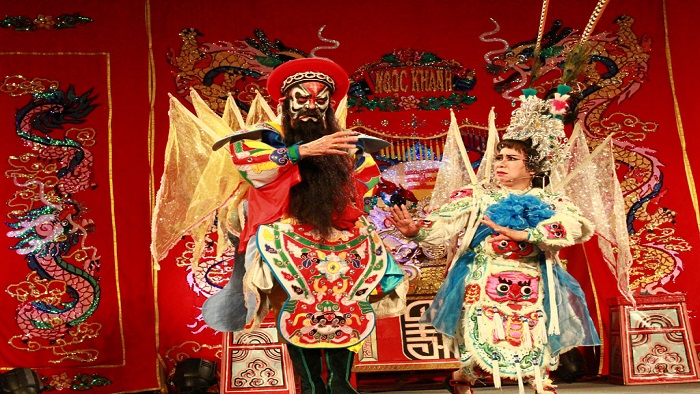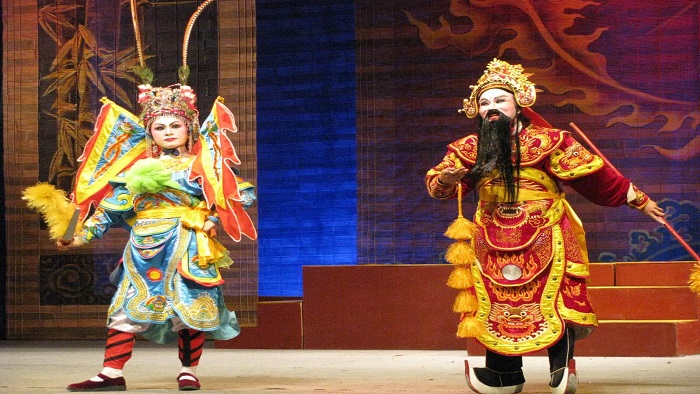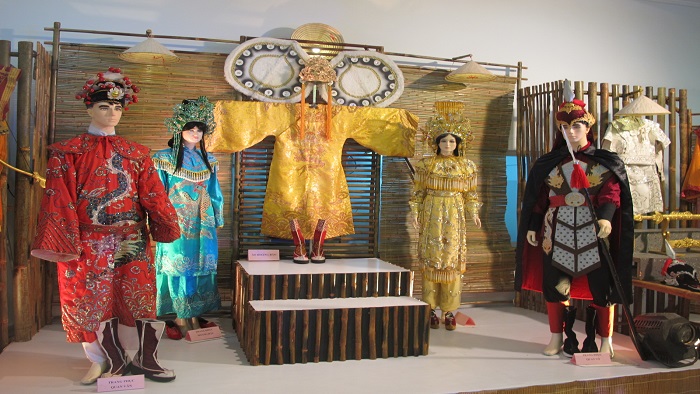
Tuong - the opera of Vietnam
Tuong (hat boi or hat bo) is a classic type of theater art that is quite unique in Vietnam. The language of the tuong is the learned literature combining with the Chinese and the Nom literature. For hundreds of years, the tuong theater has been a spiritual food that is familiar in the spiritual life of the Vietnamese people. The tuong theater is handed down from generation to generation, assembling the talents and wisdom of many generations who have dedicated themselves to this kind of art. It has the potential power to overcome the tempest of time to become the unique traditional theater art of the Vietnamese people, being the reason why you should definitely travel Vietnam.
History of the Tuong
It is a traditional performing art based on the ancient, diverse, and very popular folk songs, dances, and music of the Vietnamese people. According to some documents, the tuong was influenced by the “hi khuc” (Chinese) played by the Nguyen soldiers who were kept in prisons under the Tran Dynasty (13th century). However, Vietnamese tuong still had its own characteristics. At first, the tuong appeared only in the North, then followed the Nguyen Lord’s soldiers to the Cochinchina and prospered there. By the end of the 18th century, the tuong had developed completely in all aspects from literary script to performing arts. In the reign of the Nguyen Dynasty (19th century), it still held a good place in the cultural life in the royal court and in the folk. Today, this art is still considered as the "national soul" of the Vietnamese and can be compared to Chinese opera or Japanese Noh.
Types of the Tuong

A tuong performance
There is a time people classified the tuong into tuong thay (for the parents), tuong ngu (for the king), tuong cung dinh (played in royal court), tuong pho (played in several nights), tuong do (adaptation), tuong tan thoi (adapted from novels). In general, it can be divided into two types of classic tuong and folk tuong. Today, there are three movements: the North, South, and Central. The Central tuong is richer and has more national color. Binh Dinh is the cradle of the tuong, becoming the land with the famous names: Dao Tan, Nguyen Hien Dinh, etc.
The uniqueness of the Tuong
Performing art
The tuong now has been performed in the Vietnam Tuong Theater, is an interesting place where to go in Hanoi.

Inside the Tuong Theater
Performing art of the tuong has high formalization and strict rules in speaking, singing, and acting. Actors use dance and singing (speaking system, song, and tune) as two main means to describe the character and mood of the character for the audience to see and understand.
The dance is formed from the activities, psychology, and feelings in the social life of people. The main functions of dance are illustration, expression, decoration, scene, and introduction of type. The dance plays a very necessary role in performing arts. It not only stimulates emotions in acting, illustrates the dialogue, expresses mood and character, describes theatrical space but it also has the ability to independently express the character.
Space and time in the tuong are encapsulated in singing verses, dance moves with rudimentary tools, etc., so that the audience can imagine mountains, rivers, early morning, afternoon, battle, horseback riding, or the boat, etc. Therefore, the tuong do not need artistic decoration or appearance.
Music
Besides dance and singing, music in the tuong also plays a very important role and has a strange attraction, encouraging people to come and see. The orchestra is primarily responsible for supporting the actor's performance. It consists of percussion instruments: (drum, cymbals, etc.), blowing (trumpet, flute); strings (erhi, etc.), and plucking (three, four, zither, etc.). The music in the tuong includes two main parts: music (orchestra) and vocal music.
Make-up

Character creation in the tuong art
Actresses often dress in a number of general "models" that the loyal characters have the red face with long beard and the flattering characters have the fake face with short beard, etc. Actors are called "kep", including literary kep, martial kep, etc. When he plays the role of an old man, he is the literary man, martial man, woodcutter, etc. The actresses are called "dao" which contains ferocious dao, skittish dao, etc.
Costume
The costume of the characters is based on the style of the King and lords or on the costume of the ordinary people. Similar to the traditional Chinese costumes such as flags on the back or covers in the front, however, the tuong costumes are still close to Vietnamese costumes and are often simple and easy to wear so that performers can roll and dance. The tuong often have swords, knife, spear, hammer, fan, flag, whip, torch, wine, etc., as tools when performing.

The tuong costume
Meaning
The thesaurus of ancient Vietnamese plays of the tuong has approximately a few hundred, but gradually lost most of it, including some typical features such as “Son Hau”, “Tam nu do vuong”, “Dao Phi Phung”, “Trung King”, etc. The tuong has become an invaluable asset of the traditional theater and a pearl in the cultural thesaurus of the nation.
Unlike other forms of theater such as “cheo” or “cai luong”, the tuong brings the majestic sound of the loyal characters sacrificing for the country and the good things, of the lessons of human behavior between the general and private, between family and country, so it can be said that the heroic beauty is a characteristic feature of the tuong art and tuong is the theater of the heroes.
The art of tuong is a type of unique theater of Vietnam that contains the cultural values, the national spirit, and the values of art sustainable, which has been and will always be the soulmate of the Vietnamese people. This special art form is also one worthy thing to do in Vietnam so if you have a chance to visit Vietnam via Hanoi city tours, let’s enjoy it once. Thank you.















